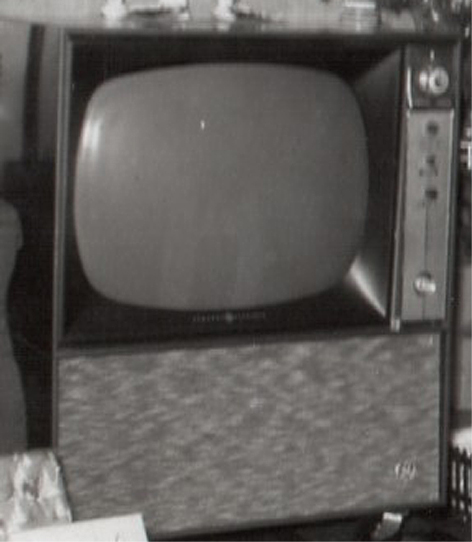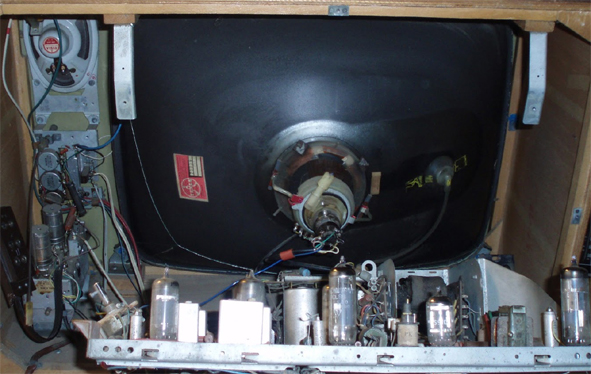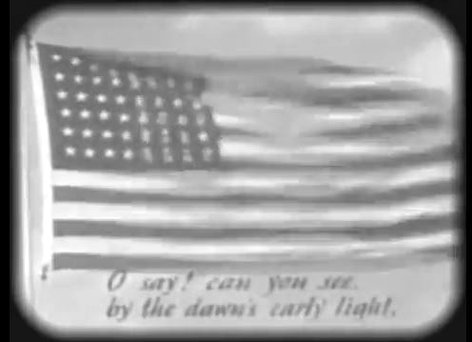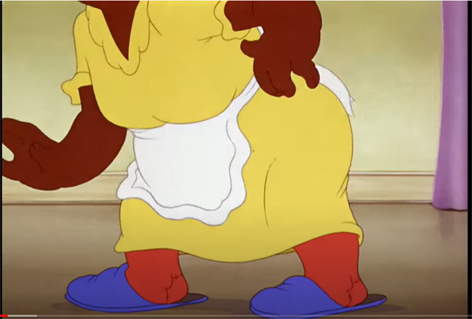-
Television
Even as I write this, there are many people who will not know that televisions were not always flat.

Our television in 1960 The TV that played a central role in my life was a huge, mahogany-esque box with a screen and speaker in front, and a removable back so you could get at the tubes and wires inside. This was necessary because “tubes”, which were essential to the working of the TV, occasionally blew and had to be replaced.

Inside the television Replacing the tubes was not something the average person did. This was a job for a specialist, and I recall a number of occasions when a man would come to our house with a travelling case full of tubes, who would remove the back of the set, fiddle with the innards, replace a tube or two and pronounce the TV fit and well. His calm and competent manner, along with his case of electronic remedies, reminded me of our doctor when he made house calls.
(Yes, kids, doctors in those days came to your house to treat you.)
The TV had an on/off button, vertical and horizontal hold dials, and a channel selector. The On/Off button protruded from the TV like a brown gum-drop and you had to pull it out to turn the set on and push it in to turn the set off, sort of like the old car door locks (more on that some other time).

Horizontal Hold gone wrong. 
Vertical Hold gone wrong. When you turned the TV on, it had to warm up. Conversely, when you shut it off, the picture didn’t disappear, it sort of faded away, shrinking into a little white dot in the center of the dark screen.
The channel selector had 14 positions—channels 1 through 13 and a strange setting for something called UHF—but we only got three channels: 6, 10 and 13. In later years, we did discover that the UHF setting could be tuned in to an alternative channel, where we could watch The Prisoner, the original Cracker and Monty Python’s Flying Circus, but for the bulk of my young life, my television viewing was limited to those three channels.
I don’t recall feeling that I was 187 channels short, nor did I find it inconvenient that you had to watch what was on TV when it was on. The world made sense then: when something was happening, you watched it. When it was over, it was something that had happened, and you couldn’t see it again. (Unless it was one of the perennial Christmas favorites, like The Wizard of Oz, or Peter Pan, starring Mary Martin as Peter, or Rudolf the Red-Nosed Reindeer, or A Charlie Brown Christmas—none of which can be shown these days because they are not PC.) In short, the concept of recording a show to watch later was unimaginable.
I also don’t recall there ever being a show we wanted to watch on one channel while another show we also wanted to watch was airing on a different channel. I assume this must have happened, but it has not made an impression, so I guess we just dealt with it.
I do recall, however, that getting up to walk across the room to change the channel was not ideal. This wasn’t because we were lazy—although we were—but because if you got up, someone would take your seat.
ASIDE:
The favored chair was The Grey Chair, followed by the couch and The Green Chair and we developed a system wherein we “called” our right to whatever seat we wanted.
“I call the Grey Chair” one of us would declare during dinner, before our TV viewing commenced.
That person could then sit in the Grey Chair until they moved out of it. Then it was up for grabs. So, we revised the system and set a time limit. From then on, if someone who was sitting in the Grey Chair wanted to go into the kitchen for something, they would say, “I call the Grey Chair for 30 seconds” and then they had to the count of 30 to get back into their seat.
In looking back, I think it is admirable that we developed this method instead of defaulting to the normal childhood system of “might makes right.”
End of ASIDE
We did have a rudimentary channel changer, however. We called it “our little brother” and it went something like this:
“Hey Marc, come in here a minute.”
Marc, toddling in from the other room, “What?”
“Nothing. But while you’re here, change the channel on the TV.”
That worked until it didn’t, at which point the scenario went more like this:
“Hey Marc, come in here a minute.”
Marc, from the other room, “Fuck you!”
Me, “I’m telling mom!”
Mom, hearing her name invoked, comes in from the kitchen, “What’s going on in here?”
Me, “Nothing. But while you’re here, change the channel on the TV.”
Fortunately, other channel-changers, I mean, younger siblings, arrived, making it unnecessary for us older sibling to have to shout, “I call the Grey Chair for 5 seconds” before dashing to the TV to turn the dial.
Because of our limited viewing options, and the abundance of interesting things to do outside, we didn’t watch a lot of television, especially when compared with the children of today. Saturday morning was the time for cartoons. That was it. You got up early—but not too early, or all you’d see was the Test Pattern—and sat in front of the TV with your Frosted Flakes to watch Tom and Jerry, Popeye, Bugs Bunny and any number of other classic cartoons that can’t be shown today due to our modern sensibilities.
The television also went off at night. After the late news, the stations would play the National Anthem and then sign off. From then on, until about 6 in the morning, there was nothing on the TV at all.

After the 11 o’clock news, you’d see this… 
…then you’d see this for a while… 
…then there would be nothing but this. During the week, there were some kid programs on in the morning to entertain the pre-schoolers so their moms could shuffle the older kids off to the school bus and pack her husband’s lunch.
Captain Kangaroo—with his side-kicks Mr. Greenjeans, Grandfather Clock, Mr. Moose, Bunny Rabbit and Dancing Bear—was an educational entertainment show. It was mercifully light on the education and good fun to watch. Within the show format were several cartoon sequences, including Tom Terrific with his Thinking Cap and sidekick Manfred the Wonder Dog, and Pow Wow the Indian Boy.

Pow-Wow wouldn’t fly today due to its
stereotypical portrayal of Native Americans
Likewise, the original Tom and Jerry cartoons,
featuring a housemaid seemingly based on
Mammy from Gone with the Wind,
which can’t be shown anymore, either.Also on offer was Romper Room. This was a franchise, so the show I watched—as was the case for most viewers—was produced locally. Delightfully amateurish, it was basically a pre-school, led by the teacher (Miss Sherry, in my case) who entertained and instructed children in her primitive classroom about being a Do-Be and not a Don’t-Be, and leading them in Bend and Stretch, while I sat on the living room floor pretending to be part of her class.
The highlight of the show was at the end, when Miss Sherry would look into her magic mirror and tell us who she could see watching her from home. When she said my name, well, that made my day.

“I see Bobby, and Susan, and Joey, and Annabelle…” But enough of this stroll down amnesia lane. These idle, idyll days didn’t last long. In 1967, when I was 12, we got a color TV. We thought that made us ultra-modern, even though the color was far from realistic. The technology improved rapidly, however, and fifteen years later, cable TV, HBO and 24-hour television became available.
The promotions for cable stated that, because it was a subscription service, there would be no commercials, and HBO promised you could “see movies at the same time they were in the theaters.” I knew this was bullshit the moment I heard it, but that didn’t stop me from getting cable and HBO.
From there, the number of channels expanded like Jiffy-Pop on a hot stove. To accommodate people who were not within reach of cables, satellite TV was born. To catch the signal, however, you needed a huge satellite dish. My dad—who still lived in the house we grew up in, which was in the back of beyond—had one. They were massive, and soon dotted the countryside. As technology improved, the dishes shrank, and the number of channels soared.

Yes, they really were that big.
Note: this is not my dad; it’s just
a random picture nicked off the webI have no idea when flat screen televisions arrived on the scene. We got one in 2008, but we were luddites—they had been around for a long time by then.
To my grandchildren’s generation, flat screens are normal, as are iPads and mobile phones. And the idea that you can’t watch whatever you want, whenever you want, on whatever device you want to watch it on, is as hard for them to conceive as the idea of more than three channels was for me.
I have to say, I enjoy the new technology, but I am glad I had the chance to know what life was like before it came along.